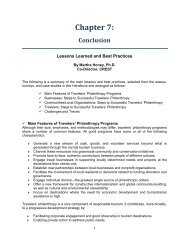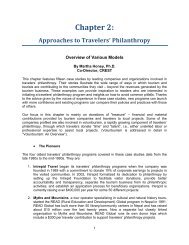Travelers' Philanthropy Handbook - Center for Responsible Travel
Travelers' Philanthropy Handbook - Center for Responsible Travel
Travelers' Philanthropy Handbook - Center for Responsible Travel
Create successful ePaper yourself
Turn your PDF publications into a flip-book with our unique Google optimized e-Paper software.
travelers who are on the verge of donating, but not yet totally decided, such incentives canmake the determining difference. So a balance of sorts is called <strong>for</strong>. You should offerincentives, and you must certainly mention them. But do not make them the core of yourappeal. Be sure to link the benefits of making a donation to the positive differences yourguests would like to make in the place. Combined with the other incentives you offer,such a campaign probably stands the greatest likelihood of success. Prospective donors demand reassurance that their money will actually do the goodthey envision when they make their donation.This reassurance can come in two basic <strong>for</strong>ms. First, guests must have confidence that themajority of the money will go directly to causes that matter to them. If prospective donorsbelieve that a large portion of their gift will be directed to paying overhead, salaries, or otherprogram administration fees, they will be reluctant to donate. If part or all of the overhead isbeing paid with money from other sources, meaning that donations are not subsidizing thesecosts, you would be wise to make this very clear. In the case of Lindblad’s philanthropy funds inGalapagos and Mexico, overhead (which until recently included board annual) is paid byLindblad Expeditions. So Lindblad guides can confidently tell their guests that 100% of theirdonations go to supporting local conservation.Justifiably or not, travelers tend to mistrust how their money will be handled when they are in a<strong>for</strong>eign country. And the magnitude of this mistrust seems amplified in developing countries bytravelers’ perceptions (and yes, sometimes misperceptions) that greedy individuals or corruptgovernment officials will be lining their own pockets with travelers’ donated money. Asdistasteful as it might seem, you absolutely must address these doubts in order to giveprospective donors confidence that the money they give will go to doing the good they envision.<strong>Travel</strong>ers prefer to give to charitable entities that have been approved by their own country’staxing authority to receive tax deductible contributions. This is the second <strong>for</strong>m of reassuranceyou can provide to help travelers feel com<strong>for</strong>table that there is oversight and legal monitoring ofthe ways in which the money will be spent. For example, the Galapagos Conservation Fund inEcuador is administered by the Lindblad Expeditions-National Geographic Foundation, which isregistered in the United States as a 501c3 charitable organization. Knowing this, Lindbladguests feel confident that their contributions will not be directed to the Ecuadorian government’sgeneral budget because the Foundation’s books are subject to U.S. federal governmentaccounting and auditing.Of course, your communication will be most compelling if you can show examples of successfullocal conservation or humanitarian projects that have been made possible by donations fromyour previous customers. They, more than anything else you might promise, will giveprospective philanthropists the reassurance they need that their contributions will make atangible difference on the ground. Apply basic communication principles <strong>for</strong> philanthropy campaigns.The basic considerations that apply to any philanthropic ef<strong>for</strong>t also apply to travelers’philanthropy. Any good fundraiser knows to suggest a target amount (if asking <strong>for</strong> monetarycontributions) as Lindblad has done with its voucher system. But make clear to your gueststhat any amount large or small is appreciated. Since these are your customers, you musttake care that your communication about the philanthropy program doesn’t make them feel“hounded” or “badgered.” A good way to avoid this is to clearly state that they are already doing148















